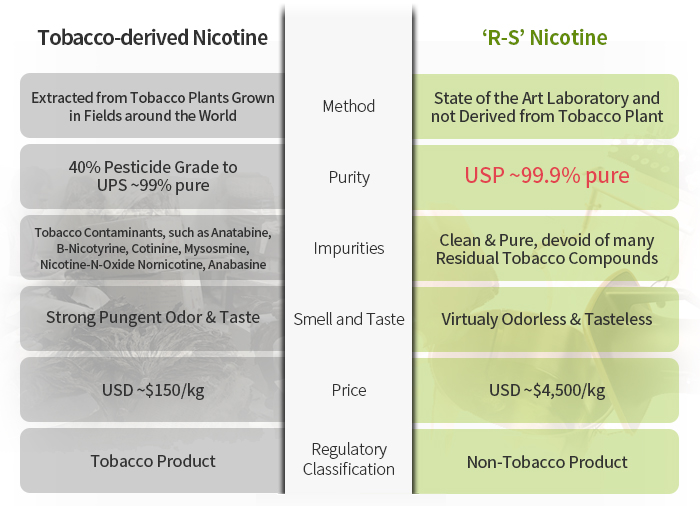본문
History & Difference
History of Synthetic Nicotine
-
Synthesized by Swiss Scientists, Ame Pictet, A and Sotschy, A
-
Synthesized by Swiss Scientists, Ame Pictet, A and Sotschy, A
-
Patent Filed in both USA and Korea for the Mass Production Method for (R)-&(S)-nicotine
-
Commercialization of (R)-&(S)-nicotine
-
Patent Approved in the USA (No. 09556142)
-
Registration with the Ministry of Environment in the Republic of Korea for (R)-&(S)-nicotine as a New Chemical Substance
-
Completion of Acute Oral Toxicity Test using (R)-&(S)-nicotine
-
Completion of Acute Dermal Toxicity Test using (R)-&(S)-nicotine
-
Patent Approved in the Republic of Korea (No. 10-1855611)
-
Patent Approved in the Republic of Korea (No. 10-1855611)
Difference between Tobacco-derived Nicotine and ‘R-S’ Nicotine
-
1. Tobacco-Specific Nitrosamines
Tobacco-specific Nitrosamines (TSNAs) consist of several harmful, cancer-causing chemicals found in tobacco and tobacco smoke. TSNAs form when tobacco leaves are grown, aged and processed. Some manufacturers intentionally increase the level of TSNAs in their tobacco to make it more potent and toxic, believing that it is what gives the tobacco its “taste.” However, conventional wisdom understands that TSNAs bound to nicotine make tobacco use lead to illness, not nicotine.
For instance, the USA does not offer price support for tobacco manufacturers that do not reduce TSNAs during the curing process. The U.S. FDA considers tobacco dependence to be a severe or life-threatening condition. Nicotine replacement therapy (NRT) products are guided to have low detection levels of TSNAs and clinically proven to be an effective smoking cessation product. It is no surprise that FDA-approved smoking cessation products have low TSNA detection and a significantly higher ratio of (R)-isomer nicotine than its combustible cigarettes. This comparison further portrays the less addictive (R)-nicotine properties than its (S)-nicotine counterpart, yet providing similar satisfaction.
Many tobacco manufacturers refine and purify their nicotine to meet USP-grade standards. Doing this process removes degrees of TSNAs and other impurities; however, it cannot be wholly eliminated from the tobacco nicotine. Our (R)-&(S)-nicotine (TFN®) is not in any way or form derived from tobacco. Therefore, it does not contain many of the TSNAs and impurities tobacco plants have and exceeds nicotine purity when compared with refined tobacco nicotine.
-
2. Usage
Tobacco-derived nicotine has historically had many use cases for thousands of years, once being called a panacea, Holy Herb, or God’s Remedy being used as a medicine for many ailments. In the 21st century, tobacco-derived nicotine has generally been consumed and utilized through combustible cigarettes and pesticides. Over the last decade, it has been quickly expanding into vaping products, such as e-liquids and head-not-burn devices, primarily being used as a smoking cessation tool. Also, with lower TSNA and the advent of synthetic nicotine that is pure and devoid of tobacco-specific contaminants, significant interest and efforts are now being placed into R&D for drug treatment against tobacco dependence, illnesses, diseases and other medical ailments, in addition to performance-enhancing drugs. Historically, all things once considered before combustible cigarettes became the norm for nicotine consumption and the stigma of illness now associated with it through smoking.
-
3. Comparison of Prices
Before vaping took form, the average price of tobacco-derived nicotine was around ~$0.90/g, then reduced to ~$0.15/g through mass production. Before our patented method for mass production, synthetic nicotine was ~$1,100/g, then reduced to ~$4.5/g through mass production.
-
4. Comparison of Effects
Both tobacco-derived nicotine and our (R)-&(S)-nicotine are pharmacologically active. Laboratory studies show they share many of the same physicochemical properties, such as the many benefits of nicotine consumption. However, it is without a doubt that (S)-nicotine is more potently toxic and has the highest binding affinity to the addiction-related nAChRs’ receptor in humans.
Both FDA and the WHO have a clear objective to reduce tobacco dependence through addiction; with our equal ratio of (R)-&(S)-isomer nicotine, giving it a simple and distinguishable 0* optical rotation, TFN® holds a promising future to reduce tobacco dependence once and for all.
-
5. South Korea Classification of Tobacco Products
The scientific community has well documented the carcinogenic effects of tobacco-specific nitrosamines (TSNAs). In [year], a tobacco manufacturer in South Korea exposed its surrounding community to substantial TSNAs by releasing them into the air. This unfortunate public event has left many community members to develop tumors and cancers, and ultimately death- resulting in a public outcry for more robust regulation against tobacco.
As of January 1, 2021- revisions to the Korean Tobacco Business Act no longer consider nicotine extracted from the tobacco leaf to be solely defined as a tobacco product rather than the entire tobacco plant. This revision includes nicotine extracted from tobacco roots and stem, as any nicotine extracted from the tobacco plant is contaminated with TSNAs.
Our TFN® is not derived in any way or form from tobacco; therefore, it does not have tobacco-specific contaminants. Furthermore, our unique ratio of 50% of each (R)-&(S)-isomer nicotine serves to provide nicotine at satisfying yet less addictive levels.
-
6. How to Distinguish
Each (R)-isomer and (S)-isomer nicotine have different optical rotation degrees. Tobacco nicotine is generally >140*, whereas our TFN® is a simple 0* optical rotation due to the equal ratio of both (R)-&(S)-isomers. Therefore, distinguishing our TFN® from tobacco nicotine is a simple check process, in addition to fake synthetic nicotine products.
Another simple method is that our TFN® is not tobacco-derived; therefore, it does not have any tobacco contaminants. A simple check for tobacco alkaline contaminant, such as Anabasine, will distinguish whether the nicotine is tobacco or synthetically made.

